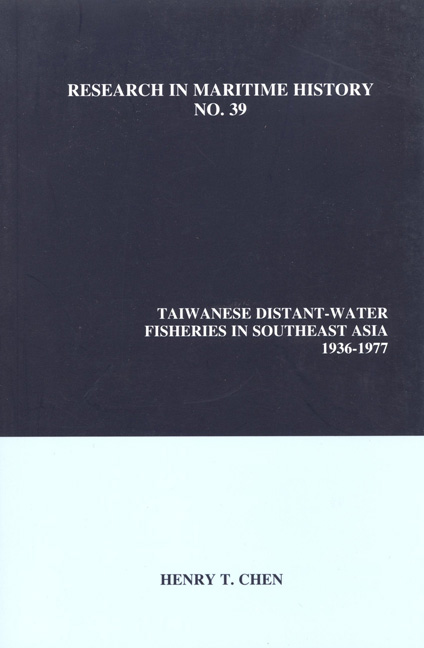Book contents
- Frontmatter
- Contents
- List of Tables
- List of Illustrations
- Notes on the Sources
- About the Author
- Acknowledgements
- Introduction
- Chapter 1 Japan and the Development of Taiwan's Fishing Industry
- Chapter 2 The Revival of the Fishing Industry in Postwar Taiwan
- Chapter 3 Kaohsiung Fishing Port and Its Fishing Ancillary Industries
- Chapter 4 The Taiwanese Fishing Industry and the Military-Political Complex
- Chapter 5 The Kaohsiung Fishing Industry and Its Ancillary Industries
- Chapter 6 The Development of Kaohsiung's Fishing Companies
- Chapter 7 Daily Lives at Sea, Fishing Zones and Politics
- Chapter 8 The Culture and Daily Life of the Kaohsiung Fishing Communities
- Chapter 9 The 1970s Crisis in the Taiwanese Fishing Industry
- Conclusion
- Appendix 1 List of Informants
- Select Bibliography
Chapter 6 - The Development of Kaohsiung's Fishing Companies
- Frontmatter
- Contents
- List of Tables
- List of Illustrations
- Notes on the Sources
- About the Author
- Acknowledgements
- Introduction
- Chapter 1 Japan and the Development of Taiwan's Fishing Industry
- Chapter 2 The Revival of the Fishing Industry in Postwar Taiwan
- Chapter 3 Kaohsiung Fishing Port and Its Fishing Ancillary Industries
- Chapter 4 The Taiwanese Fishing Industry and the Military-Political Complex
- Chapter 5 The Kaohsiung Fishing Industry and Its Ancillary Industries
- Chapter 6 The Development of Kaohsiung's Fishing Companies
- Chapter 7 Daily Lives at Sea, Fishing Zones and Politics
- Chapter 8 The Culture and Daily Life of the Kaohsiung Fishing Communities
- Chapter 9 The 1970s Crisis in the Taiwanese Fishing Industry
- Conclusion
- Appendix 1 List of Informants
- Select Bibliography
Summary
After the Second World War there were dramatic changes in the character of the Kaohsiung Fishing Port. Besides the construction of major facilities and the development of ancillary industries, the ethnic composition of Kaohsiung's fishing industry differed markedly from the colonial era on two important grounds. First, the Japanese had been expelled, and their companies and fisheries-related enterprises were taken over by the government of the Republic of China (ROC) in 1945. Second, several waves of migration from various parts of Taiwan had provided Kaohsiung's fishing industry with a diversity of ethnic groups. The Penghuans, mainland Chinese, Siao Liouciounese and native Taiwanese all played crucial roles in specific segments of Kaohsiung's fishing industry.
The Penghuans comprised the main source of labour in the distant-water fisheries, especially in the longline sector. They generally served as employees on the vessels and few ever started their own companies. The mainland Chinese, primarily from Shandong and Fujian, worked mostly for the private trawling companies and seldom entered the longline fishery. Because of this, they were greatly affected by the implementation of the 200-mile Exclusive Economic Zone (EEZ). Most disappeared from Taiwan's fishing industry after international fishing cooperation ended in the 1980s. Most of the fishers from Siao Liouciou stayed in the longline fishery. They invariably started their careers in offshore longlining in the waters off Siao Liouciou and gradually extended their fishing into Southeast Asian waters. To survive in Kaohsiung's metropolitan environment, the Siao Liouciou people formed a self-contained and closed community; each member, from vessel owners to fishing masters and apprentices, was a kinsman. The conservative nature of the fishers from Siao Liouciou has to a degree limited their potential in the global fisheries.
The local Taiwanese from Kaohsiung, on the other hand, never concentrated on any particular fishing sector. Most restarted their businesses by operating longline fishing companies after World War II, but they also made attempts to launch other activities. Hence, their capital was sometimes invested in trawlers, sometimes in longliners, sometimes in the offshore fisheries and sometimes in the distant-water sector. If they were able, they often extended their business interests into the ancillary industries, such as shipbuilding and ice manufacturing. A wide range of investments not only improved their chances of survival in an erratic business environment but also enhanced their capability to engage successfully in the global fishing industry of the postwar era.
- Type
- Chapter
- Information
- Publisher: Liverpool University PressPrint publication year: 2009



